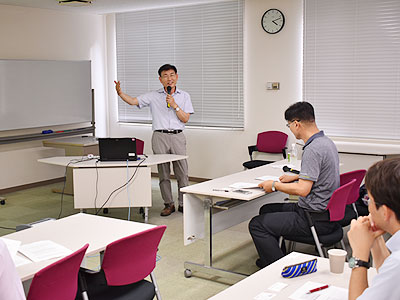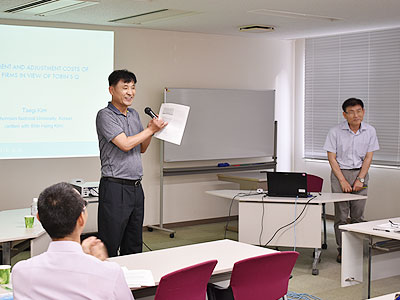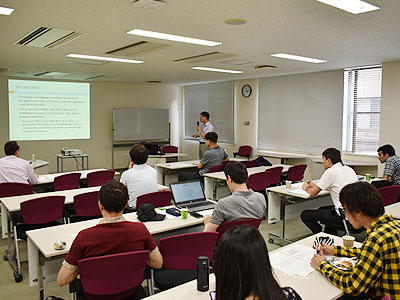- HOME
- NOTICES
- Seminar Report “Investment and Adjustment Costs of Korean Firms in view of Tobin’s q” and “Dynamic Factor Adjustment and Corporate Tax Reduction in the Japanese Manufacturing Industry”
Seminar Report “Investment and Adjustment Costs of Korean Firms in view of Tobin’s q” and “Dynamic Factor Adjustment and Corporate Tax Reduction in the Japanese Manufacturing Industry”
On Thursday, June 6, 2019, RCAPS welcomed Prof. KIM Taegi of Chonnam National University, and APU-APM Prof. KIM Sangho to deliver a jointly-held Seminar.[Report by Prof. KIM, Sangho (APM)]
In the first half of the seminar, Prof. Taegi Kim presented his paper, “Investment and Adjustment Costs of Korean Firms in view of Tobin’s q.”
His presentation explained investment decisions of Korean firms in view of Tobin’s q, and examines whether the adjustment costs of investment in group firms are lower than those in independent firms by using firm-level data for 1,106 Korean manufacturing firms over the period 1982 to 2015. He showed that Tobin’s q is a significant determinant of investment, and the adjustment costs of investment are smaller in group firms than in independent firms. He suggested that group firms invest more than independent firms due to lower adjustment costs, and consequently contribute to economic growth through investment expansion.
His presentation was well organized and invoked intensive comments from Prof. Yamakata and Prof. Fan. A couple of graduate students also participated with their own comments. The interaction between presenter and floor lasted about 15-20 minutes. His paper was very interesting and showed a well-executed empirical study to graduate students. I will discuss the paper to teach how to model and implement empirical investigation in my graduate seminar classes. The presentation provided some research ideas to participants.

Prof. KIM Taegi (Chonnam National University)

Prof. Kim Sangho (APU-APM)
In the later half of the seminar, I (Prof. Sangho Kim) presented my paper, “Dynamic Factor Adjustment and Corporate Tax Reduction in the Japanese Manufacturing Industry.” The study investigates dynamic factor adjustment and corporate tax reduction in Japanese manufacturing industry using a dynamic dual approach. The own-price elasticity of the output supply is negative in the long run, whereas that of demand for labor is positive both in the short- and long-run. This is consistent with facts that output grows slowly despite deflation and employment level is irresponsive to wage changes. Labor and capital reach the new equilibrium 7-11 years after policy shocks. Providing a tax reduction as an incentive to firms for raising wage turns out to boost not only capital investment but also employment.
There has been some comments and discussions after my presentation. However, those are less active because the paper is much technical than the first one as Prof. T. Kim indicated.
Two papers share the same basic dynamic model at the beginning but go totally different direction in their motivations and empirical emphasis. In this regard, one student told me he was surprised that one optimization model can be used so differently. And one undergraduate student told me that he learned Tobin’s q in a class. Students saw that classroom learning is related with actual research. Overall, the seminar provided an opportunity for participants to learn and see some new researches in person.
Considering all, it was a successful seminar that rewarded participants greatly.

- TOPIC
- セミナー

